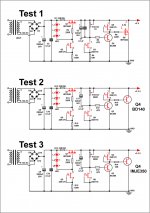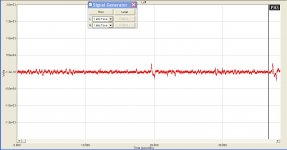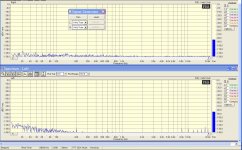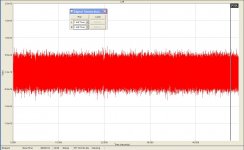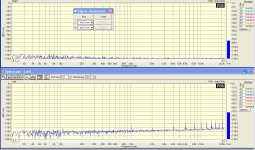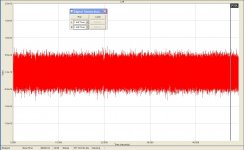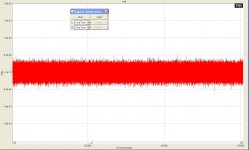For smaller voltage output decrease the value of R18 and R16. The current limit is set by R25. To get 45V output Q8 would have to be replaced with some higher voltage npn.
10k & 11k, could I use a 10k trimmer pot to fixe the voltage needed? any suggestion for higher voltage npn Q8?
Yes, you could use a trimmer, but after you find the right value it would be best to use fix value resistors. For Q8 you could try BC546B.
With a carefully chosen GND layout, the problem is now solved.
(Thanks Salas 🙂)
Please share?
I remouve R= 10 Ohm
and I Change C 220uF// Trimmer by Tantalum capacitor 22uF or 47uf!
I see the sound is like! only this cap.
What do you think about the change???
and I Change C 220uF// Trimmer by Tantalum capacitor 22uF or 47uf!
I see the sound is like! only this cap.
What do you think about the change???
BD140. Avoid tant caps. Most distortion, bad reliability. You probably liked the elevated 2nd harmonic they contribute. Test1 circuit shows Q6 reversed.
Ok! I use Bd140 ad 3.3 v and not use Tant caps!
Such design for CCS V1.2 shunt v1 looks great!
But inconsistent with the V-in source, it is difficult for DIY?
V1.0 is a complete design and simple
Such design for CCS V1.2 shunt v1 looks great!
But inconsistent with the V-in source, it is difficult for DIY?
V1.0 is a complete design and simple
I don't understand the question. Please rephrase.
I say that:
The Salas low shunt
V1.0 is a complete design and simple , And the sound excellent for DAC, for pre and phono...,can adjust from 3-50V out put!
Because it is very simple and it is easy for all people make it,
Now , i test at 3.3v out, it is good!
I think quanghao was commenting that he has found the V1.2 of the shunt to have inconsistent performance (probably requiring tweaking) depending on the input voltage and that this may cause it to be more difficult for a DIY project available to the masses.
he has not had this trouble with V1
thats how I understood it anyway.
he has not had this trouble with V1
thats how I understood it anyway.
I think quanghao was commenting that he has found the V1.2 of the shunt to have inconsistent performance (probably requiring tweaking) depending on the input voltage and that this may cause it to be more difficult for a DIY project available to the masses.
he has not had this trouble with V1
thats how I understood it anyway.
Yes! Salas shunt low V1.0 , it is very excellent, and very simple,
you can use at 3V.3 to 80V, it is very stable!
I think quanghao was commenting that he has found the V1.2 of the shunt to have inconsistent performance (probably requiring tweaking) depending on the input voltage and that this may cause it to be more difficult for a DIY project available to the masses.
he has not had this trouble with V1
thats how I understood it anyway.
😕 Maybe he wants more Vin and the fet cascode shorts his target. Or he got it oscillating in some layout as a hybrid. The fets need proper Idss relations.
yeah I dunno what hes done mate, just acting as interpreter 😕 even after my attempt to clarify above, his post in reply to it does not help me and probably not you either; understand.
we do know hes happy with V1 though, so thats good right??
we do know hes happy with V1 though, so thats good right??

Ok! I use Bd140 ad 3.3 v and not use Tant caps!
Such design for CCS V1.2 shunt v1 looks great!
But inconsistent with the V-in source, it is difficult for DIY?
V1.0 is a complete design and simple
It seems quanghao did a hybrid design using v1.2 CCS in a v1 shunt and had trouble in the implementation.
He likes original v1 (simple and effective).
Today I measured SSHV V1.0 DB140 and MJE at 3.3V using the following results
Today I measured SSHV V1.0 DB140 and MJE at 3.3V using the following results
1. BD140 At 3.3V
Today I measured SSHV V1.0 DB140 and MJE at 3.3V using the following results
1. BD140 At 3.3V
Attachments
- Status
- Not open for further replies.
- Home
- Amplifiers
- Power Supplies
- The simplistic Salas low voltage shunt regulator
